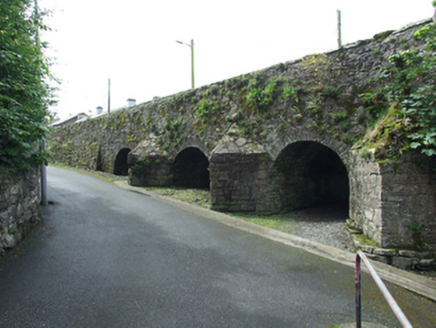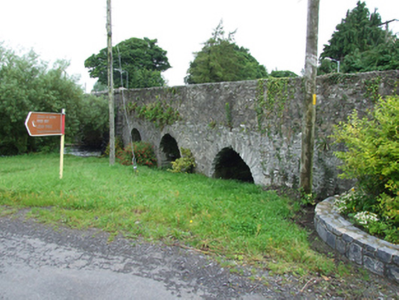Survey Data
Reg No
40404104
Rating
National
Categories of Special Interest
Archaeological, Architectural, Artistic, Cultural, Historical, Social, Technical
Original Use
Bridge
In Use As
Bridge
Date
1640 - 1660
Coordinates
240234, 281434
Date Recorded
23/07/2012
Date Updated
--/--/--
Description
Seven-arch road bridge spanning River Inny, built c.1650. Originally the bridge had nine arches but the central three arches were replaced by a single-arched central section in rusticated limestone, with rusticated limestone coping and dressed limestone voussoirs, c.1877. A limestone plaque on the bridge marks these 1877 works. The central arch is flanked by early-seventeenth century sections with three smaller arches to the north and the south, constructed with random limestone with cut limestone voussoirs. These smaller arches are separated by triangular-shaped breakwaters on the upstream side of the bridge. An early-seventeenth century sandstone armorial plaque is found on the east side of the bridge. This plaque was moved to its present location during the 1877 works. Located to the west end of the village of Finnea.
Appraisal
The Bridge of Finnea occupies an historically important and strategic crossing point between Leinster and Ulster on a short stretch of the Inny between Lough Sheelin and Lough Kinale. It is still the only direct road connection between Westmeath and Cavan to this day and it continues to play an important role in the social and economic make-up of the area. There is evidence of wicker-centering to one of the arches to the south of the bridge indicating an early date. A number of the original corbels used in the construction of this wicker-centering still remain insitu. The thickness of the masonry between the arches at the end sections of the bridge also suggests considerable antiquity. There is also clear evidence to suggest that the bridge was widened on the east (upstream) side at some stage prior to the 1877 works. The present breakwaters were probably built to replace earlier examples obscured by this bridge widening scheme. A number of battles have taken place around the bridge due to its great strategic importance. The most important of these confrontations are two battles between Cromwellian and Confederate forces in 1644 and again in 1651. A freestanding monument to the south of the bridge is dedicated to the heroics of Myles 'Slasher' O'Reilly during the 1644 battle (incorrectly dated 1646 on the memorial). There is also documentary and archaeological evidence which indicates that the bridge (or earlier bridge or ford) was defended by a castle on the Leinster side from c.1397 to c.1644 (RMP WM001-001---) and later a star-shaped fort (WM001A001---) was constructed c.1650 in a defensive position a short distance downstream from the bridge. he bridge is also mentioned in a number of poems and songs, including the Percy French penned 'Come back Paddy Reilly to Ballyjamesduff'. The 1877 works formed part of a building programme undertaken by the Upper Inny Drainage Board in 1877. The Cartographic evidence from the First Edition Ordnance Survey Map of the area in 1838 clearly shows that the Inny was considerably wider at this time. This suggests that the Inny was dredged/deepened in the centre as part of these 1877 works, thus draining the sides and making the smaller arches to the north and south redundant. A number of bridges over the Inny, such as those at Camagh and Stonestown were also built or rebuilt at this time. The span and construction of the bridge are best appreciated from the river bank, a popular fishing spot. The smaller arches of older sections of the older sections of the bridge allow pedestrian access under the road, enhancing the local amenity. The pre-1700 fabric of the bridge is of archaeological note, whilst the carved armorial crest is of artistic merit. It has been suggested that the plaque displays the arms and initials of Richard Nugent, the first Earl of Westmeath, which would date the plaque (and possibly the bridge) to sometime between 1621 and 1641. (Manning 1997, 30). The bridge remains an important and historic landmark that provides a focal point to the village.































